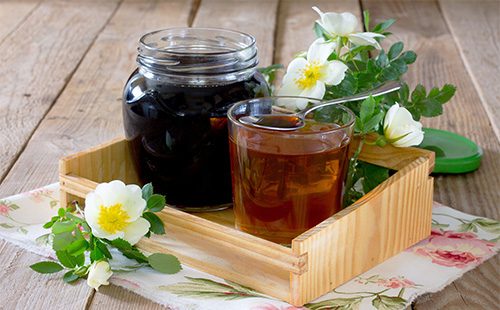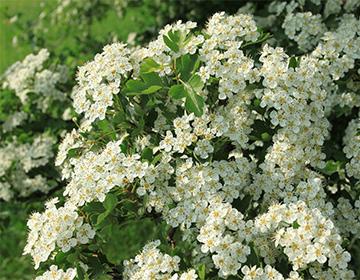The content of the article
Unlike other representatives of the genus, cinquefoil is a rare plant. Now it is considered an endangered species in most European countries. In Russia, he is protected by the Red Books of the Lipetsk, Ryazan, Moscow, and Smolensk regions. In the Bryansk region, culture is cultivated artificially as a medicinal raw material and to replenish natural reserves. Due to the external attractiveness and the ability to form a snow-white carpet in the spring, gardeners also breed five-fingers.
Botanical characteristic
The cinquefoil became rare due to the intensification of agricultural activity, the active plowing of the plain expanses on which the plant is best established. In addition, five-fingered seeds germinate extremely poorly and can remain in a "sleeping" state for several years. The most valuable, the underground part, is growing very slowly. To get a rhizome suitable for use in medicine, it takes about ten years to grow a culture.
On the territory of Russia grows in the black earth band. In the north, in the center and in the south of the European part. It is equally common in the tundra, the steppe region. It often grows in bright forests - oak and coniferous. Usually spreads on the edges and in copses. The plant is unpretentious to the soil: it can develop on loamy and sandy loamy soils, which are rather poor in nutrients. However, on nutritious soil it grows more intensively. You can recognize a plant in the wild by morphological characteristics.
- General form. Herbaceous perennial, up to 20 cm high.
- Underground part. It is represented by a developed root system consisting of rhizome and its branches - lateral roots. The rhizome is rather thick, fleshy, covered with a scaly bark of brown color. On a break almost white. Branches weakly.
- The stalks. Thin, brittle, cylindrical. Branched at the base. Hairy with short silky hairs, slightly leafy.
- Leaves. Basal long-leaved leaves of complex structure - consist of five oval-shaped leaves with a wedge-shaped base. Less commonly appear ternary. Petioles pubescent. Color - deep green, leathery, shiny surface. The underside is downy. The hairs are visible along the edge, because of which it seems that each sheet has a “halo”. Basal leaves have brown bent stipules. More than two reduced leaves are rarely present on the stem.
- Flowers. Located on pedicels with a silky (from hairs) surface. On one plant, up to three flowers are present. Corolla consists of five white petals. A characteristic feature is the presence of a green star in the center of the flower. It is formed by an overgrown receptacle connected to the fused corolla petals and stamens. The plant blooms in April-May.
- Fruit. Located on a convex receptacle. The fruit is an oval multi-root.
Kuril tea and other types of cinquefoil
Despite the fact that the cinquefoil is a special representative of its kind, it is often confused with other species. Although they are useful, they are ineffective in the main indication of pyatipal - diseases of the thyroid gland. To distinguish between raw materials, you should know the difference between species.
- Shrubbery. Popularly known as Kuril tea. Varieties with multi-colored flowers are bred. It is used as a tonic, anti-inflammatory and tonic. Great ornamental plant. Bushes reach a height of 1.5 m, and in the spring are covered with attractive flowering.
- Upright. Another name is galangal. It is appreciated for its ability to prevent and eliminate uterine bleeding, regulate metabolic processes, and strengthen the body before the cold season.
- Goose. In folk medicine, only the aerial part of the plant is used to improve digestion. For the same purpose, veterinarians give grass to cattle. Differs from pyatipal even more miniature and yellow flowering.
- Silver. It is characterized by a ribbed stem and silvery pubescence on all parts. The flowers of the plant are yellow, small. Used in the treatment of diseases of the stomach, liver, intestines. It is applied externally to eliminate skin problems.
Harvesting raw materials
In folk medicine, all parts of a plant are of medicinal value. But only the root is suitable for treating the thyroid gland and metabolic disorders. The preparation of five-fingered is as follows.
- Collection. Rhizomes accumulate the maximum amount of nutrients in the fourth year of plant development. Harvesting previously impractical - the rhizomes are too small and will not bring significant benefits. They begin to collect at the end of autumn after the dying part of the green part. When harvesting in early spring, they are guided by growing basal leaves. Dig the roots with a shovel or small diggers.
- Training. Rhizomes and roots are carefully shaken off the ground. Branches, rotten parts are cut off. Only the thickened part of the rhizome is to be dried, the length of which is most often about 10 cm. The raw materials are washed under cold running water and laid out in a thin layer on a wire rack. Place it in the shade outdoors for several days. Due to this, the roots are dried and less damaged during drying and storage.
- Drying. For complete drying, the rhizomes are cut into 1-2 cm long pieces. They are laid out in a thin layer on a pallets covered with paper or cloth. Dried in a warm attic or in a dryer. In the second case, observe the temperature regime up to 50ºС.
Harvesting is carried out twice during the summer - in June and August. Mostly basal leaves are collected, which are dried in a shaded and well-ventilated place.
Composition
The chemical composition of the culture is unique. The underground part and the grass contain almost identical compounds, but there are more of them in the rhizome, which is due to its value. All parts of the plant are rich:
- phenolcarbolic acids;
- tannins;
- saponins;
- iridoids;
- flavonoids.
The substance albinin, concentrated only in rhizomes, has thyrotropic properties. It is this component that other types of cinquefoil lack for effectiveness in terms of thyroid disorders.
In medicine, the nutrient composition of a plant is appreciated.Thanks to him, pyatipal not only stimulates the immune system and exhibits general strengthening properties, but also regulates the mineral and other types of metabolism. According to scientists, in rhizomes there are all chemical compounds known to science in balanced proportions. Easily digestible forms of iodine, selenium, zinc, manganese are of particular value.
The use of herbal remedies in dermatology is due to the content of tannins in the grass. These compounds have a number of beneficial skin properties:
- anti-inflammatory;
- hemostatic;
- astringent;
- regenerative;
- antiexudative;
- antibacterial.
Healing properties
The healing effects of the culture are due to the influence of the plant on metabolic processes. By normalizing the thyroid gland, the plant optimizes metabolism, after which hormonal disorders in other areas disappear, and chronic diseases are easier to treat.
The grass has a restorative and tonic effect. In eastern medicine, it is brewed as a tonic tea. The roots are able to treat serious pathological conditions.
Thyroid Impact
As a concentrate of useful elements and iodine, cinquefoil normalizes the trophism of the thyroid gland, improves the functioning of its cells, and prevents tumor diseases of the organ. Such properties have official confirmation, since the influence of culture has been studied in a clinical setting. Endocrinologists can recommend the plant with:
- thyrotoxicosis;
- hyperthyroidism;
- hyperplastic processes;
- endemic goiter;
- thyroid adenoma.
System effects
Cinquefoil removes excess salt from the body, exerting a mild diuretic effect. This explains the ability of the plant to slightly lower the pressure in case of hypertension, to regulate the mineral balance disturbed during gout and osteochondrosis. The removal of salts provides a mitigation of the symptoms of ailments, the elimination of pain, crunch, swelling and other discomfort. Systemic anti-inflammatory action will be appropriate for rheumatic joint damage.
For the digestive tract
All types of culture are valued for anti-inflammatory, antispasmodic and antibacterial effects on the mucous membranes of the digestive system. Pyatipal is used for chronic ailments of the stomach, liver and intestines, for the prevention of relapse. Also, the plant helps to cope with diarrhea of various origins, normalizes the absorption of fluid in the intestines, relieves colic and improves digestion.
For skin diseases
The cinquefoil is used as an external remedy for joint pain, infectious and inflammatory skin lesions. Powders of rhizomes are sprinkled with suppuration and non-healing wounds. The use of herbal remedies for the treatment of mucous membranes is appropriate. Rinses rinse your mouth with stomatitis, periodontal disease, an unpleasant odor. They are also used for douching with cervical erosion and inflammation of the vaginal mucosa.
Prescription Drugs
White cinquefoil is dispensed in pharmacies in the form of medicinal plant materials, packaged rhizome powder for making tea, Pyatipal alcohol extract and the well-known dietary supplement in the form of capsules and cream for the thyroid gland Endonorm. Having access to medicinal plant materials, it is possible to prepare medicinal compounds at home.

Alcohol extract
Features Drops similar to Pyatipalu are prepared according to this recipe. They are used for the treatment of thyroid gland and gynecological pathologies, used for prophylactic purposes, as well as for general strengthening of the body.
Preparation and use
- 50 g of roots, powdered or simply finely chopped, is poured into a glass container of 0.5 quality vodka.
- Shake the mixture, leave to infuse in a dark place for 21 days
- After the expiration of the infusion, the product is filtered, squeezing the raw materials.
- Store in the refrigerator.
- Take 30 drops of the drug three times a day before meals. Allowed to repeat monthly courses with an interval of ten days.
Water extraction
Features An aqueous extract is used internally for the treatment of thyroid gland and joint diseases, as well as for violations of the kidneys. Outwardly used for compresses and lotions for dermatological problems.
Preparation and use
- A tablespoon of raw material is poured into a thermos. Pour with two glasses of boiling water.
- Cork tightly, leave to insist on a night.
- After straining, take half a glass three times a day before meals or use externally.
Contraindications cinquefoil: periods of pregnancy and lactation, individual sensitivity to the plant. Before taking (for any indication), it is preferable to consult a doctor. It is undesirable to use the plant in the acute period of gastritis or stomach ulcers. The culture is non-toxic, but prolonged use, the possibility of use in children and adolescents should be agreed with a specialist.

